If you want to know about the site analysis or principle of daylighting design or active and passive solar architecture, please click the link.
Building orientation is an essential aspect of passive design, which is an approach to building design that maximizes the use of natural energy flows and minimizes reliance on mechanical systems for heating, cooling, and lighting. A well-designed building orientation can significantly reduce the energy requirements of a building and improve its overall comfort.
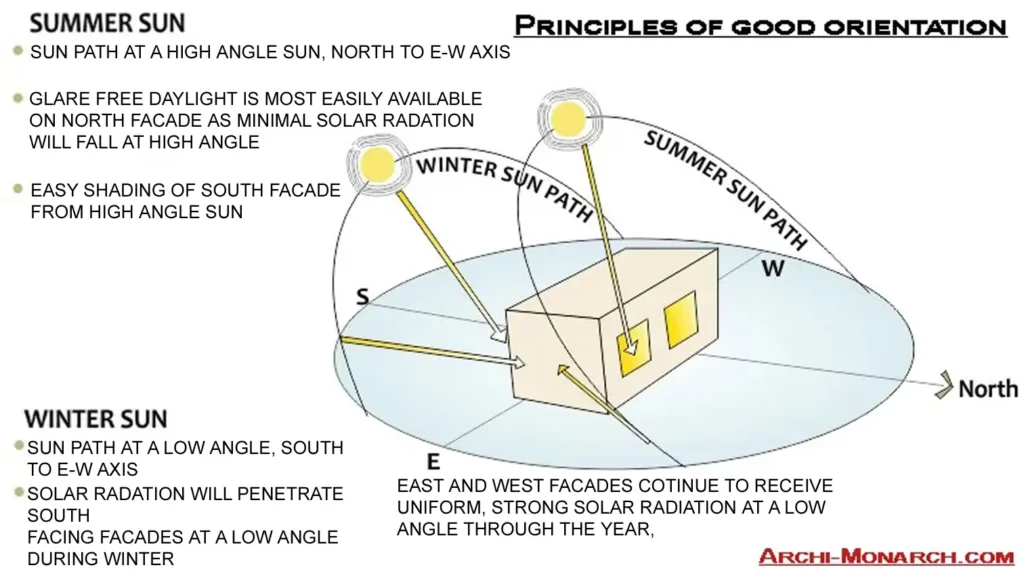
Orientation
- Orientation is the positioning of a building in relation to seasonal variations in the sun’s path as well as prevailing wind patterns.
- Good orientation can increase the energy efficiency of your building, making it more comfortable to live in and cheaper to run.
- Identify your climate zone and develop an understanding of appropriate design responses by referring to Design for climate.

- Orientate your home to make best use of sunlight and winds.
1) Principles of good orientation
- Good orientation, combined with other energy efficiency features, can reduce or even eliminate the need for auxiliary heating and cooling, resulting in lower energy bills, reduced greenhouse gas emissions and improved comfort.
- It takes account of summer and winter variations in the sun’s path as well as the direction and type of winds, such as cooling breezes.
- Good orientation can help reduce or even eliminate the need for auxiliary heating and cooling, resulting in lower energy bills, reduced greenhouse gas emissions and improved comfort.
- In hot humid climates and hot dry climates with no winter heating requirements, aim to exclude direct sun by using trees and adjoining buildings to shade every façade year-round while capturing and funnelling cooling breezes.

- In all other climates a combination of passive solar heating and passive cooling is desirable.
- North orientation is generally desirable in climates requiring winter heating, because the position of the sun in the sky allows you to easily shade northern façades and the ground near them in summertime with simple horizontal devices such as eaves, while allowing full sun penetration in winter.
- North-facing walls and windows receive more solar radiation in winter than in summer.
- As shown in the diagram below, the opposite is true for other directions — and why, in mixed or heating climates, it is beneficial to have the longer walls of a house facing north to minimize exposure to the sun in summer and maximize it in winter.

- Average daily solar radiation on vertical surfaces.
2) Analysis for the best orientation
- Prioritize your heating and cooling needs.
- Are you in a climate that requires mainly passive heating, passive cooling, or a combination of both?
Your local climate research should study:
- temperature ranges, both seasonal and diurnal (day–night).
- humidity ranges.
- direction of cooling breezes, hot winds, cold winds, wet winds.
- seasonal characteristics, including extremes.
- impact of local geographic features on climatic conditions (see Choosing a site).
- impact of adjacent buildings and existing landscape.
3) Orientation for passive heating
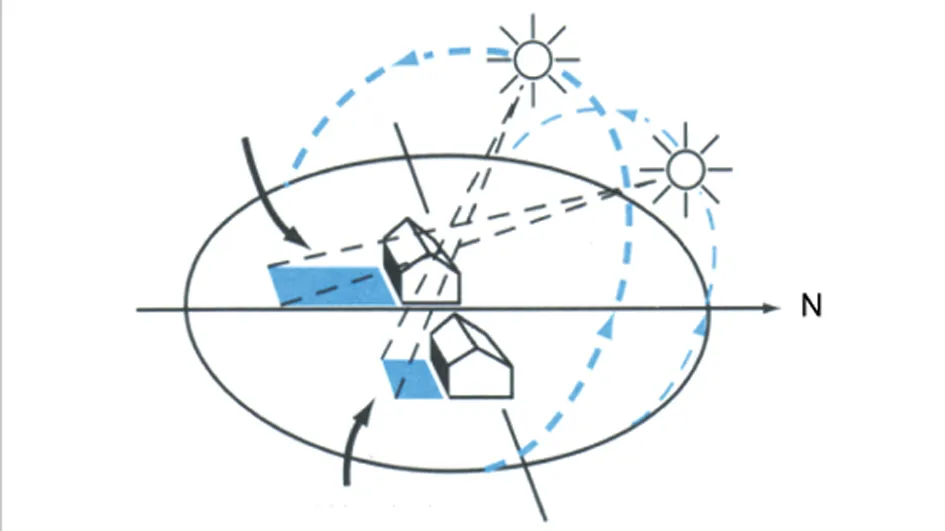
- Sun movement from high angle in summer to low angle in winter.
- Orientation for passive heating is about using the sun as a source of free home heating by letting winter sun in and keeping unwanted summer sun out.
- It can be done with relative ease on northern elevations by using horizontal shading devices to exclude high angle summer sun and admit low angle winter sun.
- ‘Solar access’ is the term used to describe the amount of useful sunshine striking glass in the living spaces of a home.
- The desired amount of solar access varies with climate.
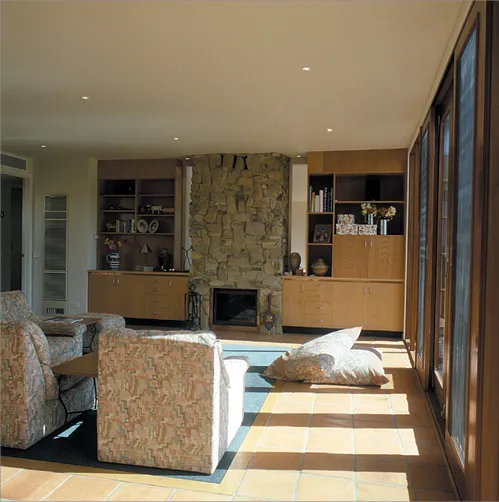
- The sun is a source of free home heating.
- First, establish true or solar north for your region.
- This is useful in all climates whether you are encouraging or excluding solar access.
- Ideal orientation (in most climates) is solar north, orientations of up to 20° west of north and 30° east of north still allow good passive sun control.
- As can be seen from the diagram below, good solar orientation is possible on most sites.
- Variations in orientation towards east and west can have advantages in some climates and for some activities.
For example
- In cold climates, orientations west of north increase solar gains in the afternoon when they are most desirable for evening comfort, but east of north can warm the house more in the mornings, improving daytime comfort for those who are at home then.
- In warmer climates, orientations east of north can allow better capture of cooling breezes.
- Poor orientation and lack of appropriate shading can exclude winter sun and cause overheating in summer by allowing low angle east or west sun to strike glass surfaces at more direct angles, reducing reflection and increasing solar gains.

- Orientation does not have to be precise: there is a degree of flexibility.
4) The site
- You can achieve good passive solar performance at minimal cost if your site has the right characteristics.
- Where possible, choose a site that can accommodate north-facing daytime living areas that flow to outdoor spaces with similar orientation.
- In tropical areas, northerly solar access is not desirable: sites that allow maximum exposure to cooling breezes and designs that draw or funnel them through the building are preferable.
- On smaller sites achieving permanent solar access is more likely on north–south blocks because they receive good access to northern sun with minimum potential for overshadowing by neighbouring houses.
- In summer, neighbouring houses can provide protection from low east and west sun.
- However, on narrow blocks, careful design is required to ensure sufficient north-facing glass is included for adequate passive solar heating.

Orientation possibilities on a cul-de-sac.
- North–south sites on the north side of the street allow north-facing living areas and gardens to be located at the rear of the house for privacy.
- North–south sites on the south side of the street should be wide enough to accommodate an entry at the front as well as private north-facing living areas.
- Set the house back to accommodate a north-facing garden and consider creating a private outdoor living courtyard with plantings or even a garage on the northern boundary where planning permits.

The lower angle of winter sun can limit solar access.
- Sites running east–west should be wide enough to accommodate north-facing outdoor space.
- Overshadowing by neighboring houses is more likely on these sites — particularly if multi-level housing is permitted, as winter sun is lower in the sky, particularly in southern latitudes.

Orientation on slopes.
- A north-facing slope increases the potential for access to northern sun and is ideal for higher housing densities.
- A south-facing slope increases the potential for overshadowing.
- Your design for solar access should not compromise that of your neighbours.
- At subdivision level, smaller individual lots are ideally located on north-facing slopes where they still receive solar access at increased densities.
- South-facing slopes are often better suited to medium density where party walls can be designed to provide thermal buffers and smaller floor areas can be solar heated with carefully designed and shaded east or west-facing windows using advanced glazing.
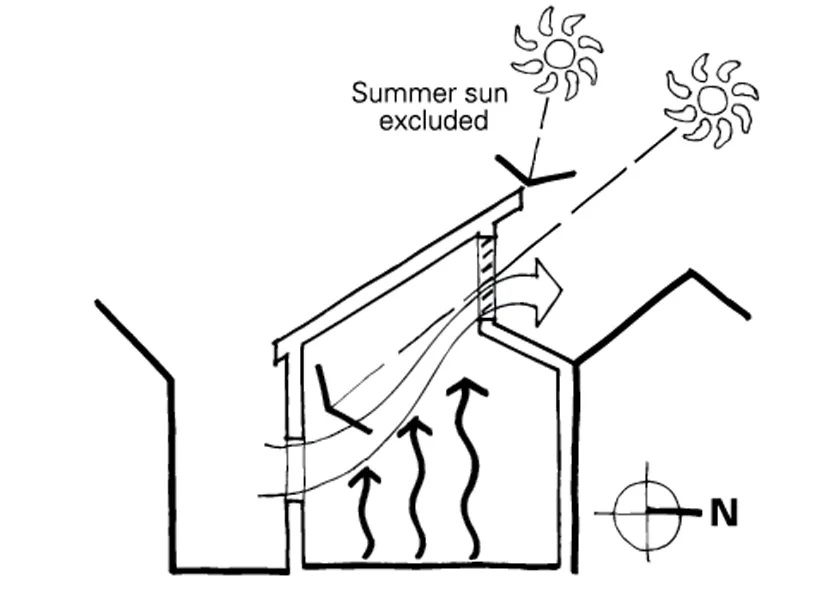
High level openable windows capture winter sun and create cooling currents in summer.
- Views to the north are an advantage, as north is the preferable direction to position windows and living areas.
- If the view is to the south, avoid using large areas of glass in order to minimize winter heat loss or use mirrors to reflect north sun onto the glass.
- Clerestory (high level) windows can be used to capture winter sun and create stack ventilation (rising hot air) in summer.
- Sunlight entering through clerestory windows should strike thermal mass at lower levels so that heat is stored for later release.
- Failure to do this can produce pockets of heat in high level, uninhabited spaces that is quickly lost through the glass at night.
- Clerestory windows should not be used in cold climates unless carefully designed, as daytime heat gains rarely offset night-time heat losses and cold draughts are unavoidable.
5) The house
- The ideal orientation for living areas is within the range 15°W–20°E of true or ‘solar’ north (although 20°W–30°E of true north is considered acceptable).
- It allows standard eaves overhangs to admit winter sun to heat the building and exclude summer sun with no effort from the occupants and no additional cost.
- Poor orientation can exclude winter sun as well as cause overheating in summer by allowing low angle east or west sun to strike glass surfaces, creating a greenhouse effect where it’s not required.
- Choose a house that has good orientation or can be easily adapted for better orientation.
- Build close to the south boundary to maximize sunny, north-facing outdoor living areas and protect solar access but avoid compromising the solar access of neighbours.
- Choose a home with living spaces that have good access to winter sun.
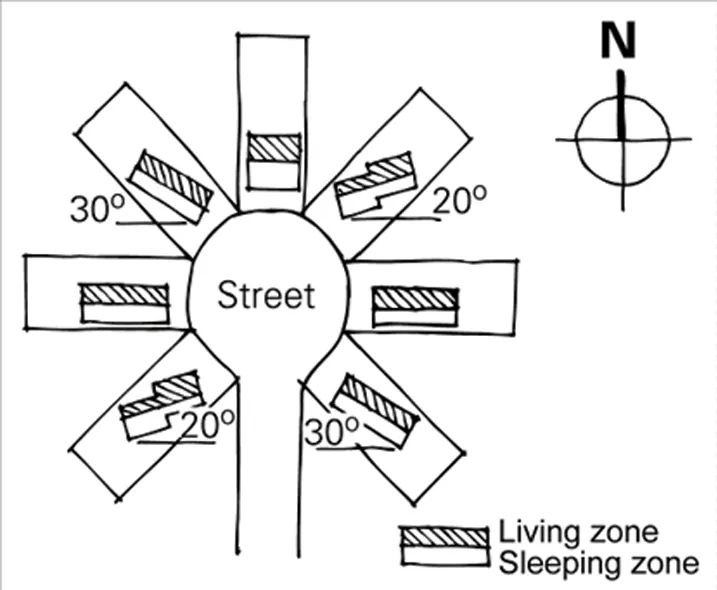
Daytime living areas shown shaded.
- Look for a suitable area of glass on north-facing walls with access to winter sun. As a general guide this should be 10–25% of the exposed thermal mass floor area of the room.
- This rule can vary considerably depending on design, glazing type and exposed thermal mass.
- Check that west-facing glazing is not excessive in area and is properly shaded to prevent overheating. West-facing walls receive the strongest sun at the hottest part of the day.
- Check that there is no significant detrimental overshadowing (of both windows and roof where photovoltaics and solar hot water may be located) by adjacent buildings and trees.
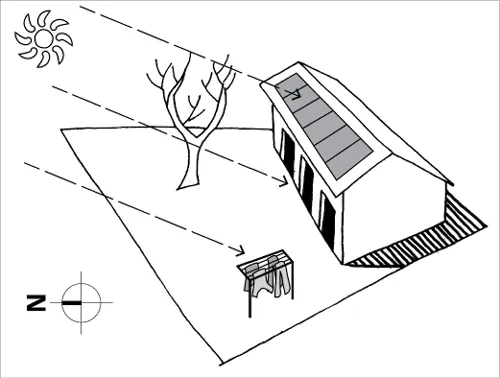
Northern side of the house is free from major obstructions.
- Ensure year-round solar access for clothes drying and solar collectors.
- When renovating, adjust floor plan and orientation to trap the winter sun and encourage summer breeze flow by adding new windows, changing openings and relocating rooms that block breezes and sun.

Original floor plan.

New floor plan.
Overall, building orientation is a crucial aspect of passive design that can significantly reduce a building’s energy requirements and improve its overall comfort. By carefully considering the sun’s natural energy flows, shading, ventilation, site-specific factors, and thermal mass, a building can be oriented to maximize its natural energy efficiency.
This post on building orientation for passive design is incredibly insightful! I love how you highlighted the importance of natural light and ventilation in creating energy-efficient spaces. The practical tips you provided can really help homeowners and architects alike to make more sustainable decisions. Looking forward to implementing some of these strategies in future projects!